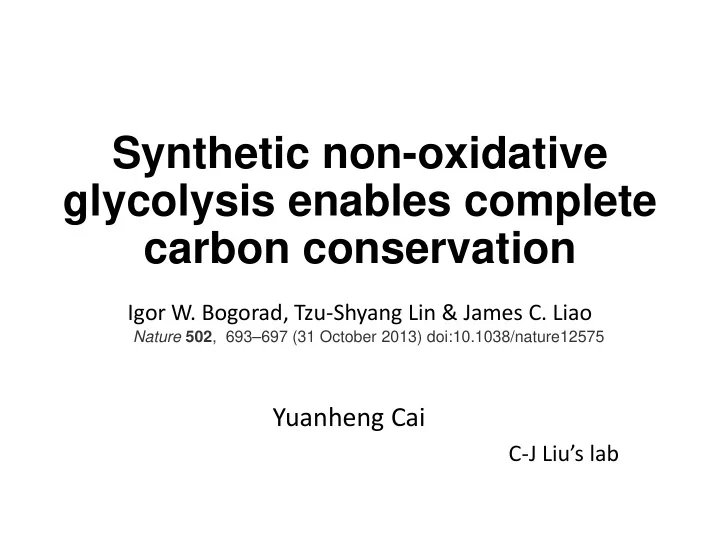

Synthetic non-oxidative glycolysis enables complete carbon conservation Igor W. Bogorad, Tzu-Shyang Lin & James C. Liao Nature 502 , 693–697 (31 October 2013) doi:10.1038/nature12575 Yuanheng Cai C-J Liu’s lab
Why I Think You Should Know About This Work • “This pathway solved one of the most significant limitations in biofuel production and biorefining: losing one-third of carbon from carbohydrate raw materials; this limitation was previously thought to be insurmountable because of the way glycolysis evolved.” • This new synthetic pathway could be used with many kinds of sugars, which in each case have different numbers of carbon atoms per molecule, and no carbon would be wasted. • This new pathway could be used in biofuel production using photosynthetic microbes
Why I am Interested in This Work • The pathway has a potential to enable us to use lignocellulosic materials more efficiently.
Glycolysis 1. Glucose + 2 NAD + + 2 ADP + 2 P i → 2 Pyruvate + 2 NADH + 2 H + + 2 ATP + 2 H 2 O 2. Glycolysis occurs, with variations, in nearly all organisms, both aerobic and anaerobic. 3. It occurs in the cytosol of the cell
Pyruvate Decarboxylation (aerobic) Carbon loss 1. By PDC. Produce AcCoA, serving as a link to the TCA cycle. (In mitochondria for eukaryotes or in cytoplasm and plasma membrane for prokaryotes) 2. AcCoA involves in isoprenoids, flavonoids, polyketides and fatty acids biosynthesis 3. AcCoA serves as the building blocks for biorefinery
Structure of oxidative (EMP) and non-oxidative glycolysis (NOG) 1a. Phosphoketolase (Fpk); a. F6P as input (2 more F6Ps required) 1b. Phosphoketolase (Xpk) b. 3F6P → 3AcP+3E4P (1. Pkt) c. 3E4P → 2F6P
Carbon rearrangement OP FBP dependent carbon rearrangement : SBP dependent carbon rearrangement: 2. Transaldolase (Tal); 9. SBP aldolase 3. Transketolase (Tkt); 10. sedoheptulose-1,7-biphosphotase 4. Ribose-5-phosphate isomerase (Rpi); 5. Ribulose-5-phosphate epimerase (Rpe); 6. Triose phosphate isomerase (Tpi); 7. FBP aldolase (Fba); 8. Fructose 1,6-bisphosphatase (Fbp)
Three FBP-dependent NOG networks. a. NOG using only Fpk; b. NOG using only Xpk; c. NOG using one Fpk with two Xpk activities but without the use of one type of Tkt reaction.
Pentose and triose sugar phosphate NOG networks
In vitro NOG-expression of NOG enzymes(FBP dependent)
In vitro NOG-expression of NOG enzyme activity assay Gpd, glycerol-3-phosphate dehydrogenase; Pfk, phosphofructokinase; Glk, hexokinase; Zwf, glucose-6-phosphate dehydrogenase; Pgi, phosphoglucose i
In vitro NOG-total activity a, In vitro conversion of F6P to AcP using eight purified core enzymes, including F/Xpk, Fbp, Fba, Tkt, Tal, Rpi, Rpe and Tpi. The starting F6P concentration was 10 mM. The red triangles are reactions with all eight enzymes present. The blue squares are reactions with all enzymes except Tal. b , In vitro conversion of F6P to acetate, determined by HPLC. The addition of Ack and Pfk allowed the complete conversion of AcP to acetate. Acetate was monitored at 210 nm (A 210 nm ). c, Conversion of three sugar phosphates—F6P, R5P and G3P—to near stoichiometric amounts of AcP. 10 mM of each substrate was converted to AcP using the same core enzymes (denoted ‘all’), whereas ‘no Tkt’ controls produced much less. In vitro enzyme assays were independently performed in triplicates and error bars indicatestandard deviation (s.d.).
In vivo conversion of xylose to acetate using NOG Expression of F/Xpk and Fbp from JCL118 with pIB4. Figure 4 In vivo conversion of xylose to acetate using NOG. a, Pathways in E. coli strains (JCL16, JCL166, JCL118) with NOG for converting xylose to acetate and other competing products (lactate, ethanol, succinate and formate production). Plasmid pIB4 was transformed into these strains for the expression of F/Xpk (from B. adolescentis ) and Fbp (from E. coli ) under the control of the P L lacO 1 promoter. b, The expression of Fbp and F/Xpk in JCL118/pIB4 was tested by purifying the crude extract on a His -tag column, and then running a coupled colorimetric assay to test AcP formation. The control was JCL118 (without plasmid), which did not produce AcP. c, Xylose was converted to acetate and other products under anaerobic JCL16, WT conditions. Strain JCL118 ( Δ ldhA Δ adhE Δ frdBC Δ pflB ) produced a near theoretical JCL166, Δ ldhA , Δ adhE and Δ frdBC ratio of acetate/xylose. In vivo production data were independently repeated JCL118, Δ ldhA , Δ adhE , Δ frdBC and Δ pflB three separate times from frozen glycerol stocks. Error bars indicate s.d.
Conclusion
Thank you
Recommend
More recommend